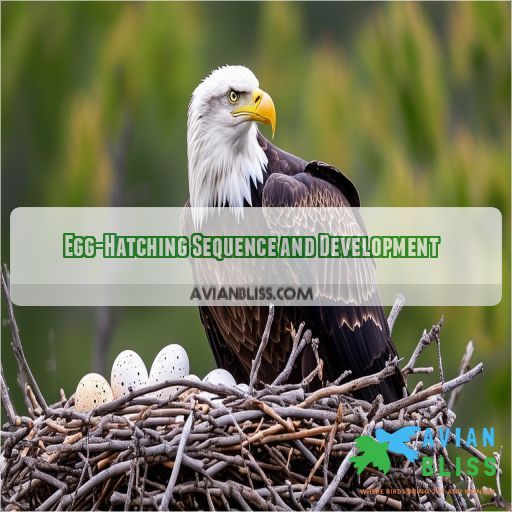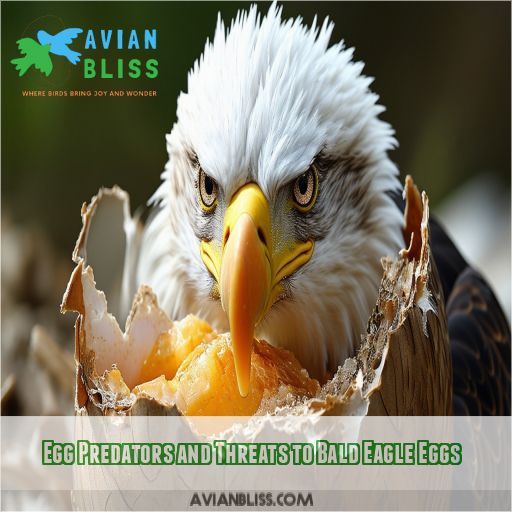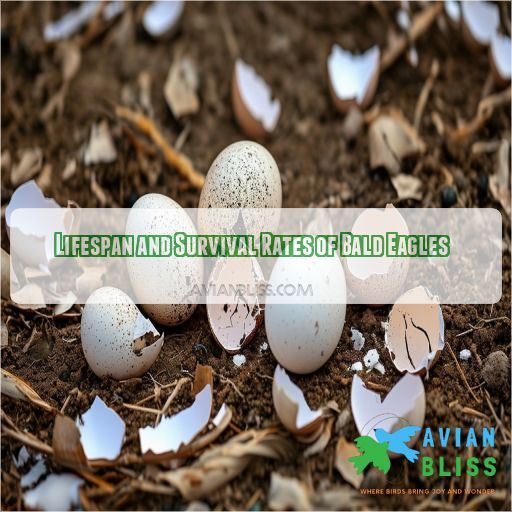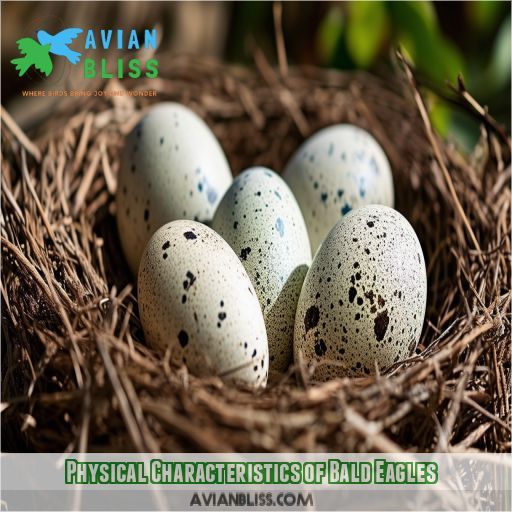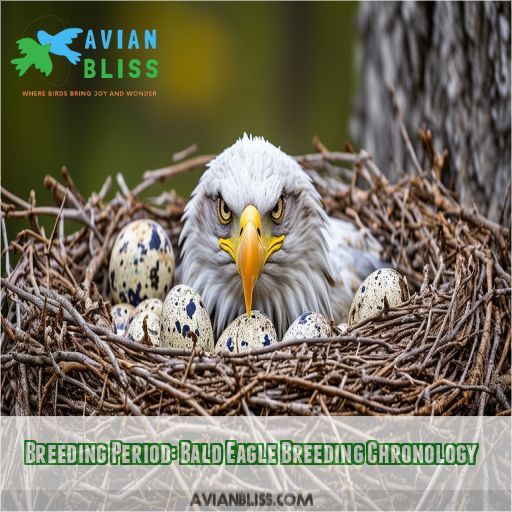This site is supported by our readers. We may earn a commission, at no cost to you, if you purchase through links.

You are going to learn about the timing and methods of their lay, how long their incubation takes, and problems these eggs endure.
Get ready to be equipped with knowledge on the most iconic symbol of freedom in nature.
Table Of Contents
- Key Takeaways
- Egg Appearance & Characteristics
- Egg-Laying Process in Bald Eagles
- Incubation Period and Parenting Roles
- Egg-Hatching Sequence and Development
- Egg Predators and Threats to Bald Eagle Eggs
- Lifespan and Survival Rates of Bald Eagles
- Physical Characteristics of Bald Eagles
- Nesting Behaviors and Nest Structure
- Breeding Period: Bald Eagle Breeding Chronology
- Non-Breeding Period and Bald Eagle Nest Atlas
- Frequently Asked Questions (FAQs)
- How long does it take for bald eagle eggs to hatch?
- What color is a bald eagle egg?
- How many eggs does a bald eagle lay?
- Do bald eagles leave eggs unattended?
- Can bald eagle eggs be artificially incubated?
- How do environmental pollutants affect bald eagle eggs?
- Are there legal regulations for collecting bald eagle eggs?
- Can infertile bald eagle eggs be used for research?
- How do researchers safely monitor bald eagle eggs?
- Conclusion
Key Takeaways
- Dive into the captivating world of bald eagle eggs, from their snowy-white appearance to their perilous journey to hatching.
- Witness the unwavering devotion of eagle parents who protect their eggs with a watchful eye and cozy brood patches.
- Marvel at the resilience of these eggs, enduring threats from predators and environmental hazards.
- Embark on a journey of conservation, recognizing the significance of each bald eagle egg in safeguarding the future of this iconic species.
Egg Appearance & Characteristics
You will be impressed with the handsome look of bald eagle eggs. These oval-shaped beauties are a rather dingy white, a little tinged with tan, and often bear light-brown blotches.
Their latitudinal-related size differs, but usually, they’re 2.9 inches long and about 2.2 inches wide. The weight is approximately 4.4 ounces; these eggs are sturdy.
The thickness of this eggshell reflects the length of its incubation period, which is 35 days long. Clutch size is normally 2-3 eggs, but each one is an extraordinary example of nature at work.
Egg-Laying Process in Bald Eagles
You’ll find the egg-laying process of bald eagles fascinating. After courtship and nest preparation, the female begins laying eggs. Here’s what you need to know:
- Timing: First egg arrives 5-10 days post-copulation
- Interval: 3-4 days between each egg
- Clutch size: Usually 2-3 eggs, rarely 4
Egg characteristics vary, with weight around 125 grams and size about 2.9 x 2.2 inches. Their oval shape and dull white color with tan tinges make them blend into the nest. As you watch this process unfold, you’re witnessing nature’s precision in action.
Incubation Period and Parenting Roles
As eggs are settling into the cozy nest, so does real work begin.
During incubation you’ll have an incredible display of parental devotion: both mom and dad develop brood patches, which are denuded areas on their bellies that will transfer heat all the way to the eggs. The female takes the lead, spending most of her time on the nest, while dad steps in for brief relief shifts.
They’re vigilant guardians, covering the eggs with branches and leaves when they need to leave. This tireless dedication ensures the developing eaglets receive constant warmth and protection that sets the stage for them to make a grand entrance into the world.
Egg-Hatching Sequence and Development
You will see the magic of nature as the bald eagle eggs hatch after an incubation period of days. The first egg that’s laid is also the first to hatch, followed by siblings two to three days later. This staggered hatching provides an early advantage in size for the oldest chick. Shortly after emerging, the eaglet is fed by its parents and growth takes off.
Critical elements of the hatching process:
• Brood patch formation in adults for optimum incubation temperature
- Egg size varies with latitude, impacting development rates
- Nesting disturbances can affect hatching success
As you witness this remarkable journey, you’ll develop a new respect for the eagle’s hardiness and how precariously balanced the design of nature is.
Egg Predators and Threats to Bald Eagle Eggs
You’d be surprised at the threats bald eagle eggs face. Ravens, crows, hawks, and magpies are the main culprits, always on the lookout for an easy meal. Even raccoons, black bears, and bobcats occasionally join the feast.
It’s not just nature’s food chain at play. Human disturbance and habitat loss pose significant risks too. Lead poisoning from contaminated prey can wreak havoc on eagle populations.
To combat these threats, eagles have developed clever tactics. Their eggs’ camouflage blends seamlessly with the nest, while parents maintain strict nest sanitation.
In Alaska’s wintering habitats, eagles face unique challenges, adapting their nesting strategies to outwit predators.
Lifespan and Survival Rates of Bald Eagles
Though there’s a risk from predators, bald eagles do survive much beyond their egg stage. You’ll be surprised to know that these magnificent birds fight against all odds throughout their lives. Here’s what you need to know about the lifespan and survival rates of these birds:
- A captive eagle can live for as long as 48 years, but wild eagles seldom survive even half that many years.
- Only half of the eaglets—50 percent—will survive their first year, and a bare 1 in 10 live to age 5.
- The average life span of a wild Bald Eagle is about 20 years.
Environmental impact and habitat preservation play major roles in shaping the population dynamics and age distribution of bald eagles.
Physical Characteristics of Bald Eagles
You’ve learned about their lifespan, but physically these birds are just as magnificent. Bald eagles sport a wingspan of 6-7 feet, with the females typically having larger wingspans than males. These raptors weigh from 8-12 lbs, again with females being about 20% larger in weight than their male counterparts. Their body length is around 32 inches.
First-year birds actually have an extended set of "practice" feathers, which create longer wingspans.
As you learn to identify eagles, remember this: females larger, males a bit smaller—both awe-inspiring in their aerial prowess.
Nesting Behaviors and Nest Structure
You have seen the imposing wingspread of a bald eagle, but now let’s look at equally impressive nests. These are birds that are master builders constructing large nests that increase in size over the years.
You’ll find their nests placed high in sturdy trees generally over the water. Eagles fiercely defend homes weighing sometimes as much as a ton!
They’re creatures of habit, reusing and refurbishing nests year after year. Still, they may well abandon ship if they’re disturbed.
The size and positioning of the nest are critical in safeguarding their precious eggs, thereby ensuring that a new generation of this fantastic raptor will survive.
Breeding Period: Bald Eagle Breeding Chronology
In the breeding period of bald eagles, you’ll learn an exciting timeline. Typically, these birds start laying eggs early in the days of March with a clutch size varying from a single to four eggs. The laying patterns are tremendously similar, where most eagles maintain a 3-day or 4-day interval between successive eggs.
- Egg interval variations can range from 68 to 116 hours
• Seasonal influences may have an effect on the laying time and pattern.
• Clutch size often relates to the pair’s experience and food availability.
Knowing these breeding chronologies helps give an appreciation of just how finely tuned nature’s timing is in the life cycle of eagles.
Non-Breeding Period and Bald Eagle Nest Atlas
During the non-breeding period, you’ll find bald eagles exploring new territories and honing their survival skills.
The Bald Eagle Nest Atlas serves as your guide to their distribution across North America by checking out this informative resource. It’s not just about timing; it’s about understanding hotspots where these majestic birds thrive.
You’ll discover potential threats to their habitats and learn how conservation efforts are making a difference. By diving into this atlas, you’re not just observing – you’re becoming a guardian of nature’s legacy.
It’s your chance to master the art of eagle conservation and protect their freedom to soar.
Frequently Asked Questions (FAQs)
How long does it take for bald eagle eggs to hatch?
You’ll witness an incredible transformation over 35 days. The eggs, laid about three days apart, will hatch in the same order. You’ll see the first chick emerge, followed by its siblings over the next few days.
What color is a bald eagle egg?
You’ll find bald eagle eggs are primarily dull white with a tan tinge. They’re often adorned with light brown blotches, adding a unique pattern to each egg. Their oval shape and distinct coloration make them easily recognizable in the nest.
How many eggs does a bald eagle lay?
You’ll typically find two to three eggs in a bald eagle’s clutch. They’re laid at intervals, usually 3-4 days apart. While some nests may have one or four eggs, two is the most common number you’ll encounter.
Do bald eagles leave eggs unattended?
While you’d think eagles guard their nests constantly, they don’t. You’ll often find bald eagles leaving their eggs unattended, but don’t worry. They’ve got a trick up their feathers: covering the eggs with branches and leaves for protection.
Can bald eagle eggs be artificially incubated?
Artificial incubation of eagle eggs can be conducted, but that’s pretty tricky. You’ll need specialized equipment in order to hold the right temperature and humidity conditions. One needs to get closer to natural conditions because slight deviations could alter the development of the embryo inside and hamper its successful hatch.
How do environmental pollutants affect bald eagle eggs?
Environmental pollutants can wreak havoc on eggs, thinning shells and introducing toxins. You’ll find these contaminants disrupt embryo development, reduce hatching success, and cause birth defects. It’s a serious threat to the survival of these majestic birds.
Are there legal regulations for collecting bald eagle eggs?
You can’t legally collect bald eagle eggs. It’s strictly prohibited under federal law. Violation could lead to hefty fines or imprisonment. Only authorized researchers with special permits can handle eagle eggs for scientific purposes.
Can infertile bald eagle eggs be used for research?
You can use infertile bald eagle eggs for research, but you’ll need proper permits. These eggs offer valuable insights into eagle biology without harming viable populations. Always follow strict ethical guidelines and legal requirements when conducting such studies.
How do researchers safely monitor bald eagle eggs?
Like a stealthy wildlife detective, you’ll use non-invasive methods to monitor bald eagle eggs. You’ll employ remote cameras, observe from a distance, and utilize drones. You’ll also collect data on nest characteristics and surrounding habitat without disturbing the eagles.
Conclusion
From the majestic heights of their nests to the breathtaking moment of hatching, bald eagle eggs embody nature’s most spectacular journey.
You’ve discovered the intricacies of their appearance, laying process, and incubation. You’ve learned about the threats they face and the incredible survival instincts of these iconic birds.
Armed with this knowledge, you’re now part of the conservation effort. Remember, every bald eagle egg represents hope for the species’ future.
Keep watching the skies – you might just witness this miracle unfold.



